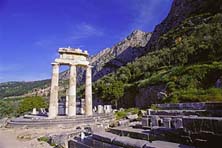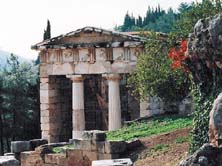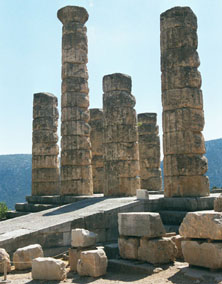|
|
|
|
|
THE FAMOUS SANCTUARY OF DELPHI
It is located in Phokis, in one of the loveliest and most impressive Greek landscapes. Its ancient ruins spread out over the southern slopes of Parnassos, beneath the looming gigantic Phaidriad rocks, known in antiquity as Yampeia and Nauplia. Such is the aplendour and magnificence of the setting that the visitor is overcome with awe and ecstasynthe at the moment he turns his gaze from the olive groves of the Pleistos valley to those rugged crags which tower over and enclose the archaeological site from north and east. Delphi was believed to be the center of the world. According to tradition Zeus, in order to find the center of the earth, sent two eagles to fly around the earth in opposite directions. Since they met over Delphi, he pointed that specific area as the center of the earth. This myth was the basis of the Greeks’ conviction that the “omphalos” or navel of Delphi was the geographical centre of the world, which in fact emphasises the importance they attached to this place. The trip also includes a visit to the monastery of Osio Lukas. In the year 946 AC he first built his cell, a small church in which to pray. He also made a beautiful garden in which he grew his vegetables. He did not, however, manage to finish it. He died in February 7, 953 at the age of 56. The monastery is famous for it's wall paintings. Those paintings have been cleaned and restored recently and they exhibit special interest.
Home of the sanctuary and oracle of the light Apollo, Delphi, was the largest religious and spiritual centre in Hellas. Its fame and prestige spread throughout the Mediterranean. Men came from all corners of the then-known world to seek the priestess's wise prophecy: state emissaries on major issues of war or peace and ordinary folk on their personal problems. The sanctuary's renown remained undimmed throughout antiquity, but when Christianity prevailed and idolatry was banned, it fell into decline and was abandoned. The Delphic sanctuary of Apollo extends over successive terraces on the lower slopes of Mount Parnassos, in a stunning location surrounded by towering crags, the Phaidrades Rocks, and with the Gulf of Itea as its backdrop.
THE HISTORY OF DELPHI
Archaeological research has shown that the area of Delphi was inhabited at least from the Mycenaean period (14th-11th c. BC). The deity worshipped here in those times was Gaia or Ge. Myth says that she dwelt in a cavern guarded by her serpentiform son, Python, and pronounced oracles for devotees. The place was thus named Pytho. When the god Apollo arrived from Delos he slew Python, after which he abandoned the area in search of purification. He returned later, expiated and crowned with a wreath, to establish his cult and the place was then renamed Delphi. Apollo took the prosonym Pythios and henceforth the oracle belonged to him. The sacred place was arranged during the 8th and the 7th c. BC. Towards the end of the 7th c BC the first stone temples were built, one dedicated to Apollo and the other to the goddess Athena. Delphi belonged politically to the Phocian city of Krissa the present village of Chrysso. In the early 6th c. BC the Amphictiony was founded, a union of city-states with common political aims. Its seat was transferred to Delphi, essentially inaugurating the history of the city. In time the Delphic Amphictiony acquired decisive responsibilities in the administration of the sanctuary.
In 582 BC it organized the Pythian games, which were held every four years in honor of Apollo and in remembrance of his victory over Python. In 548 BC the temple of Apollo was destroyed by fire and building of a new one commenced with contributions from various Greek cities. Between the 6th and 4th c. BC the sanctuary enjoyed a great heyday and was adorned with handsome edifices and numerous ex-votos dedicated to Apollo by cities and individuals. Several sacred wars affected the operation of the oracle, since Phocians, Locrians, Athenians and others coveted its wealth and interfered in its independence. Both the war against Krissa (600-590 BC) and that waged to relieve Delphi of the sovereignity of the Phocians were called sacred wars (first and second). In 356 BC the third sacred War was declared, which lasted 10 years and ended in the domination of the Phocians. Philip II of Macedon, who assumed the leadership of the Amphictiony vanquished them later. In 339-338 BC the fourth sacred war provided Philip with the pretext for invading southern Greece, which he finally conquered in the battle of Chaironeia. From 191 BC the Romans were in power. In 86 BC General Sulla sacked the sanctuary.
The Emperor Nero participated in the Pythian games and transferred 500 statues from Delphi to Rome, to grace his capital. In the 2nd c. AD Hadrian made gifts intended to boost the sanctuary's finances, but efforts to regain its former glory were to no avail. The oracle that the Pythia pronounced to the Byzantine Emperor Julian the Apostate (361-363 AD) confirms the fact that Christianity had prevailed. In 392 AD Emperor Theodosius banned the practice of ancient cult and the oracle was forced to close.
ORACLE AND PROPHECIES
Pilgrims and emissaries came from all over the ancient world to seek advice from the oracle. First they cleansed themselves in the water of the Kastalia Spring, then they paid a tax, the pelanon, and after that sacrificed an animal on the altar to Apollo. The Pythia, priestess of the god, uttered the prophecies, on a fixed day each month, except the three winter months when it was believed that Apollo was absent from Delphi, in the land of the Hyperborians. The Pythia purified herself with water from the Kastalia spring, censed the hearth and entered the adyton of the temple. There, seated upon a tripod set above a cleft in the ground, she chewed bay leaves, drank water from the Kassotis spring and inhaled the fumes that sent her into a trance. Priests and theopropoi submitted the pilgrims' questions. The oracle was written down and interpreted by the priests of Apollo. The oracles were ambiguous and could be interpreted in many ways, so that the advice of the god was never erroneous. The formal procedure of the oracle's operation was crystallized in the 6th c. BC and remained unchanged until the reign of Handrian (2nd c. AD).

|
|



